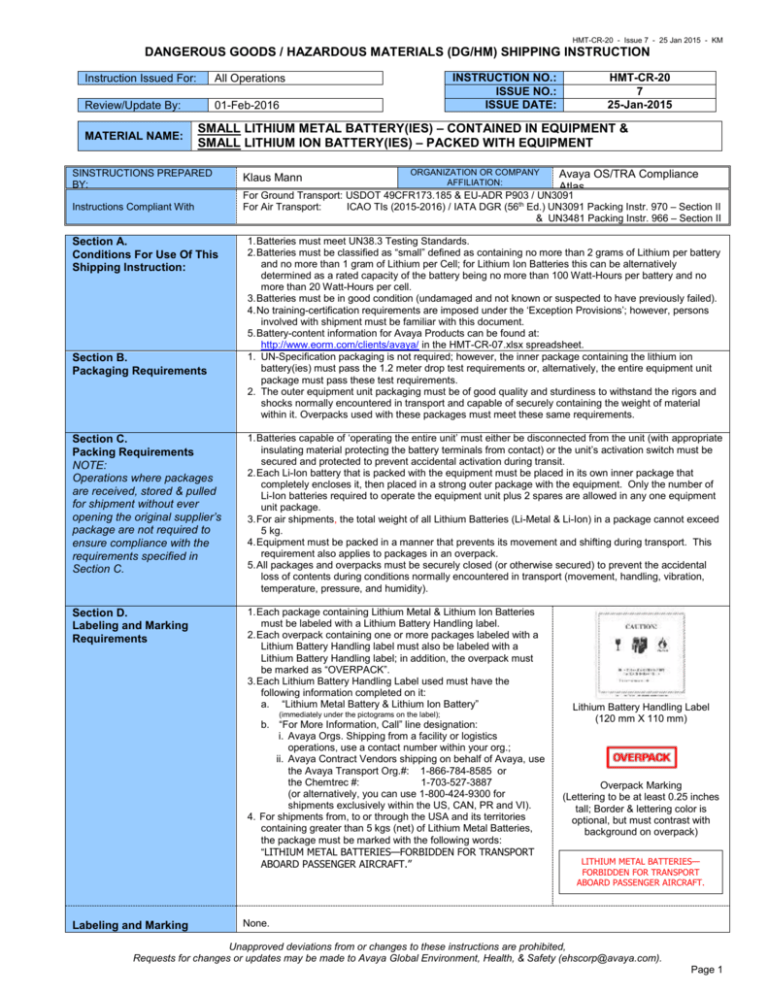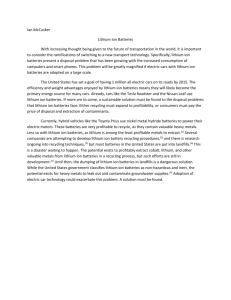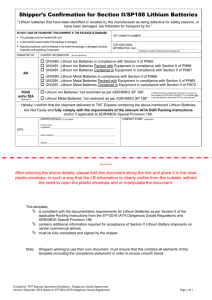Small Lithium Metal Batteries
advertisement

HMT-CR-20 - Issue 7 - 25 Jan 2015 - KM DANGEROUS GOODS / HAZARDOUS MATERIALS (DG/HM) SHIPPING INSTRUCTION Instruction Issued For: All Operations Review/Update By: 01-Feb-2016 MATERIAL NAME: INSTRUCTION NO.: ISSUE NO.: ISSUE DATE: HMT-CR-20 7 25-Jan-2015 SMALL LITHIUM METAL BATTERY(IES) – CONTAINED IN EQUIPMENT & SMALL LITHIUM ION BATTERY(IES) – PACKED WITH EQUIPMENT SINSTRUCTIONS PREPARED BY: Klaus Mann Instructions Compliant With For Ground Transport: USDOT 49CFR173.185 & EU-ADR P903 / UN3091 For Air Transport: ICAO TIs (2015-2016) / IATA DGR (56th Ed.) UN3091 Packing Instr. 970 – Section II & UN3481 Packing Instr. 966 – Section II Section A. Conditions For Use Of This Shipping Instruction: Section B. Packaging Requirements ORGANIZATION OR COMPANY AFFILIATION: Avaya OS/TRA Compliance Atlas 1. Batteries must meet UN38.3 Testing Standards. 2. Batteries must be classified as “small” defined as containing no more than 2 grams of Lithium per battery and no more than 1 gram of Lithium per Cell; for Lithium Ion Batteries this can be alternatively determined as a rated capacity of the battery being no more than 100 Watt-Hours per battery and no more than 20 Watt-Hours per cell. 3. Batteries must be in good condition (undamaged and not known or suspected to have previously failed). 4. No training-certification requirements are imposed under the ‘Exception Provisions’; however, persons involved with shipment must be familiar with this document. 5. Battery-content information for Avaya Products can be found at: http://www.eorm.com/clients/avaya/ in the HMT-CR-07.xlsx spreadsheet. 1. UN-Specification packaging is not required; however, the inner package containing the lithium ion battery(ies) must pass the 1.2 meter drop test requirements or, alternatively, the entire equipment unit package must pass these test requirements. 2. The outer equipment unit packaging must be of good quality and sturdiness to withstand the rigors and shocks normally encountered in transport and capable of securely containing the weight of material within it. Overpacks used with these packages must meet these same requirements. Section C. Packing Requirements NOTE: Operations where packages are received, stored & pulled for shipment without ever opening the original supplier’s package are not required to ensure compliance with the requirements specified in Section C. 1. Batteries capable of ‘operating the entire unit’ must either be disconnected from the unit (with appropriate insulating material protecting the battery terminals from contact) or the unit’s activation switch must be secured and protected to prevent accidental activation during transit. 2. Each Li-Ion battery that is packed with the equipment must be placed in its own inner package that completely encloses it, then placed in a strong outer package with the equipment. Only the number of Li-Ion batteries required to operate the equipment unit plus 2 spares are allowed in any one equipment unit package. 3. For air shipments, the total weight of all Lithium Batteries (Li-Metal & Li-Ion) in a package cannot exceed 5 kg. 4. Equipment must be packed in a manner that prevents its movement and shifting during transport. This requirement also applies to packages in an overpack. 5. All packages and overpacks must be securely closed (or otherwise secured) to prevent the accidental loss of contents during conditions normally encountered in transport (movement, handling, vibration, temperature, pressure, and humidity). Section D. Labeling and Marking Requirements 1. Each package containing Lithium Metal & Lithium Ion Batteries must be labeled with a Lithium Battery Handling label. 2. Each overpack containing one or more packages labeled with a Lithium Battery Handling label must also be labeled with a Lithium Battery Handling label; in addition, the overpack must be marked as “OVERPACK”. 3. Each Lithium Battery Handling Label used must have the following information completed on it: a. “Lithium Metal Battery & Lithium Ion Battery” (immediately under the pictograms on the label); b. “For More Information, Call” line designation: i. Avaya Orgs. Shipping from a facility or logistics operations, use a contact number within your org.; ii. Avaya Contract Vendors shipping on behalf of Avaya, use the Avaya Transport Org.#: 1-866-784-8585 or the Chemtrec #: 1-703-527-3887 (or alternatively, you can use 1-800-424-9300 for shipments exclusively within the US, CAN, PR and VI). 4. For shipments from, to or through the USA and its territories containing greater than 5 kgs (net) of Lithium Metal Batteries, the package must be marked with the following words: “LITHIUM METAL BATTERIES—FORBIDDEN FOR TRANSPORT ABOARD PASSENGER AIRCRAFT.” Labeling and Marking Lithium Battery Handling Label (120 mm X 110 mm) Overpack Marking (Lettering to be at least 0.25 inches tall; Border & lettering color is optional, but must contrast with background on overpack) LITHIUM METAL BATTERIES— FORBIDDEN FOR TRANSPORT ABOARD PASSENGER AIRCRAFT. None. Unapproved deviations from or changes to these instructions are prohibited, Requests for changes or updates may be made to Avaya Global Environment, Health, & Safety (ehscorp@avaya.com). Page 1 HMT-CR-20 - Issue 7 - 25 Jan 2015 - KM DANGEROUS GOODS / HAZARDOUS MATERIALS (DG/HM) SHIPPING INSTRUCTION Instruction Issued For: All Operations Review/Update By: 01-Feb-2016 MATERIAL NAME: INSTRUCTION NO.: ISSUE NO.: ISSUE DATE: HMT-CR-20 7 25-Jan-2015 SMALL LITHIUM METAL BATTERY(IES) – CONTAINED IN EQUIPMENT & SMALL LITHIUM ION BATTERY(IES) – PACKED WITH EQUIPMENT Exceptions (IF USING AN EXCEPTION, CHECK APPROPRIATE BOX AND FORWARD, WHERE APPROPRIATE, TO SHIPPING DEPT.) All equipment unit packaging containing such batteries packed with equipment and their associated overpacks are always required to be labeled (as designated above) and declared (as designated in Section F.) (CONTINUED) Section E. Shipping Paperwork / Non-Regulated (Commercial Invoices (CI), Shipper’s Letter of Instruction (SLI), etc.) For air shipments of packages containing Lithium Metal Batteries, the following information should be included on the line or lines immediately following the item description and product id: (contains Lithium Metal Battery / UN3091 Not Restricted PI970 – II) (contains Lithium Ion Battery / UN3481 Not Restricted PI966 – II) Section F. Shipping Paperwork / Regulatory-Required Bill of Lading (BOL) or Air Waybill (AWB) – Straight or Dangerous Goods Type NOTE: This section is ‘Not Applicable’ for packages that are not required to be labeled with the Lithium Battery Handling label as allowed in Section D (Labeling and Marking Exceptions). 1. A Dangerous Goods BOL/AWB is not required for Lithium Metal & Lithium Ion Batteries shipped under the Exception Provisions designated in this Shipping Instruction. Therefore, a Straight BOL/AWB or similar type document may be utilized for the required shipping paperwork. 2. Where a BOL/AWB is required (one is always required for International shipments), the following must be included on the line item(s) containing Lithium Metal Batteries: (For Ground Transport only) DG/HM Basic Description / Nature and Quantity of (Dangerous) Goods No requirement. (For Air Transport, including any ground transport to and from the freight forwarder/carrier/airport) DG/HM Basic Description / Nature and Quantity of (Dangerous) Goods LITHIUM METAL BATTERIES IN COMPLIANCE WITH UN3091 SECTION II OF PI970 AND LITHIUM ION BATTERIES IN COMPLIANCE WITH UN3481SECTION II OF PI966 3. When Lithium battery handling labels are required on packages, the following text must be contained in the BOL/AWB “Additional Handling Information” section or on a document accompanying the consignment: Packages in this consignment contain lithium batteries. Handle with care. If outer packaging is damaged, contents must be inspected for damage. Damaged batteries could become overheated and/or present a flammability hazard. Damaged batteries are not allowed to continue in air transport. Repacking may involve additional regulatory requirements which would require qualified personnel to perform. Contact ____________________________________ for additional information. (see Section D.3.b.; phone # here should be consistent with that on label) 4. The following 24-Hour Emergency Phone # must be designated on the BOL/AWB*: None Required. 5. The following Emergency Response Guide # must be designated on the BOL/AWB*: None Required. * IF THERE ARE NO SPECIFIC SECTIONS DESIGNATED FOR THIS INFORMATION, INFO. SHOULD BE INPUT UNDER THE ‘ADDITIONAL HANDLING INFORMATION’ SECTION OF THE BOL/AWB. Section G. Placard Requirements Section H. Additional Information / Instructions None Required. For Mail Services (US Postal Service and similar entities of other governments): Lithium Metal Batteries (contained in equipment) and Lithium Ion Batteries (packed with equipment) are prohibited from being placed in the mail. For passengers on commercial airlines: Lithium Metal and Ion Batteries (contained in equipment, packed with equipment or by Unapproved deviations from or changes to these instructions are prohibited, Requests for changes or updates may be made to Avaya Global Environment, Health, & Safety (ehscorp@avaya.com). Page 2 HMT-CR-20 - Issue 7 - 25 Jan 2015 - KM DANGEROUS GOODS / HAZARDOUS MATERIALS (DG/HM) SHIPPING INSTRUCTION Instruction Issued For: All Operations Review/Update By: 01-Feb-2016 MATERIAL NAME: INSTRUCTION NO.: ISSUE NO.: ISSUE DATE: HMT-CR-20 7 25-Jan-2015 SMALL LITHIUM METAL BATTERY(IES) – CONTAINED IN EQUIPMENT & SMALL LITHIUM ION BATTERY(IES) – PACKED WITH EQUIPMENT themselves) are allowed in carry-on bags only if the batteries are for personal use. Spare batteries must have their terminals protected (either by being taped over or placed in individual plastic baggies; 1 battery per baggie). No paperwork, declarations or labels required. COMPLIANCE DECLARATION INFORMATION The Compliance Declaration on the following page is not a legal requirement for the transport of a Dangerous Good / Hazardous Material, but often times is required by the Freight Forwarder and/or Carrier to demonstrate and communicate that the appropriate requirements are known by the shipper and have been used in preparation of material for shipment. Shipments prepared in accordance with the requirements and instructions on the first two pages of this Shipping Instruction may utilize this Compliance Declaration. If such document is requested, it should be completed and signed by the organization preparing the material for shipment and/or submitting it for transport. Some freight forwarders and carriers may have their own forms which should be similar to the document on the following page. In most instances, the freight forwarder / carrier will accept the completed / signed document on the following page in lieu of its form if it is asked. (continue on to next page for Compliance Declaration form) Unapproved deviations from or changes to these instructions are prohibited, Requests for changes or updates may be made to Avaya Global Environment, Health, & Safety (ehscorp@avaya.com). Page 3 HMT-CR-20 - Issue 7 - 25 Jan 2015 - KM DANGEROUS GOODS / HAZARDOUS MATERIALS (DG/HM) SHIPPING INSTRUCTION SMALL LITHIUM METAL BATTERY(IES) – CONTAINED IN EQUIPMENT & SMALL LITHIUM ION BATTERY(IES) – PACKED WITH EQUIPMENT MATERIAL NAME: DG/HM Compliance Declaration – Excepted Lithium Cell/Battery Shipments Complying With Section II of ICAO TI / IATA DGR PI 965 - 970 Air Waybill #: (IF KNOWN, OTHERWISE COMPLETED BY FREIGHT FORWARDER OR CARRIER) Flight # / Date: (IF KNOWN, OTHERWISE COMPLETED BY FREIGHT FORWARDER OR CARRIER) Final Destination: Avaya Commercial Invoice #: CHECK HERE, IF ADDITIONAL COMPLIANCE DECLARATIONS PROVIDED WITH THIS SHIPMENT. Total # of Packages With Lithium Cells / Batteries on this shipment: Identifying Markings on Packages Only Containing Lithium Cells/Batteries: Identifying Mark On Package(s) * # of Assc. Pkgs. Identifying Mark On Package(s) * # of Assc. Pkgs. Identifying Mark On Package(s) * # of Assc. Pkgs. * Designate marking on package (e.g. Product ID Nos. or shipper-placed marks such as Pkg-A, Pkg-B, etc.) that can be used to identify it. Referring to the shipment mentioned above, I hereby certify that: 1. The package(s) contain(s): Lithium Batteries in this shipment prepared in accordance with ICAO TI (2015-2016) / IATA DGR (56th Ed.) and: Lithium Ion Batteries are in compliance with UN3481 Packing Instruction 966 – Section II and Lithium Metal Batteries are in compliance with UN 3091 Packing Instruction # 970 – Section II 2. The package(s) must be handled with care and, if damaged, a flammability hazard exists. Special procedures must be followed in the event that package is damaged, to include inspection and repacking, if necessary. 3. Damaged packaging and damaged batteries are not allowed to continue in air transport. 4. If additional information is required, please call telephone # (country code + area code + tel. no.) ** ** Telephone # should be consistent with that used on label and shipping papers; see Section D.3.b. of this instruction for guidance.) 5. Packages have been prepared in accordance with Avaya DG/HM Shipping Instruction HMT-CR-20 which limits lithium battery weight (both lithium metal & lithium ion combined) to no more than 5 kg. per package. Therefore packages are eligible for transport via Cargo and Passenger Aircraft. Signature of Shipper / Authorized Agent: Printed Name and Title of Signatory: Company Name: Date:






